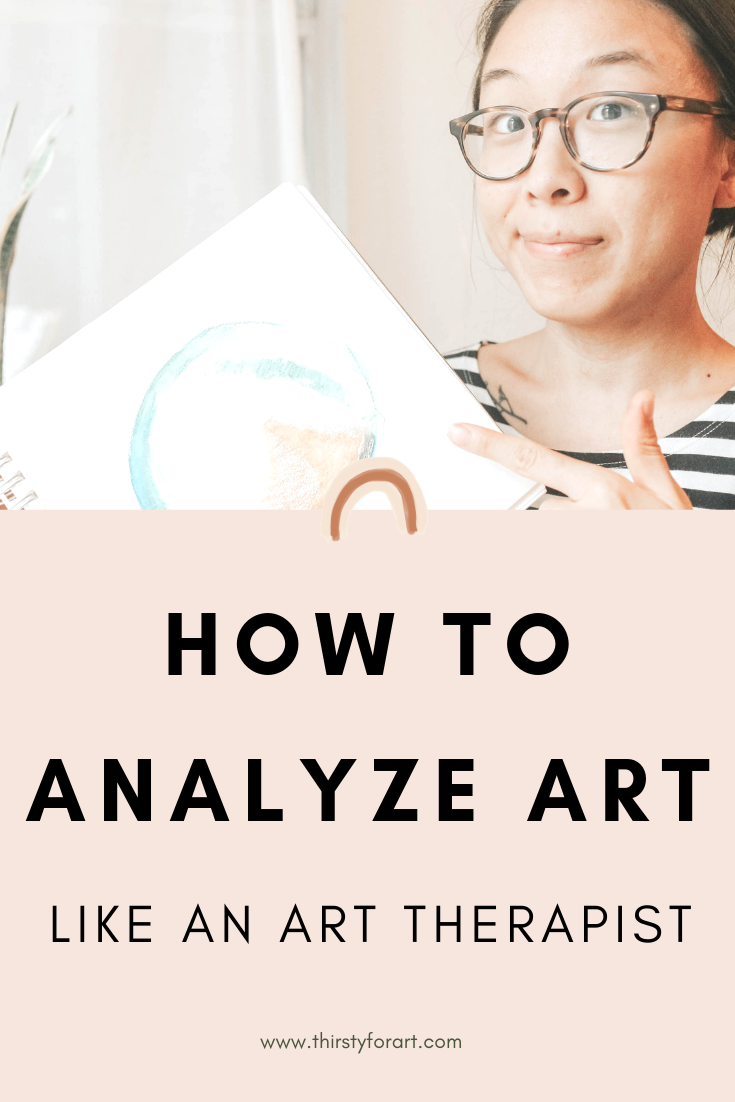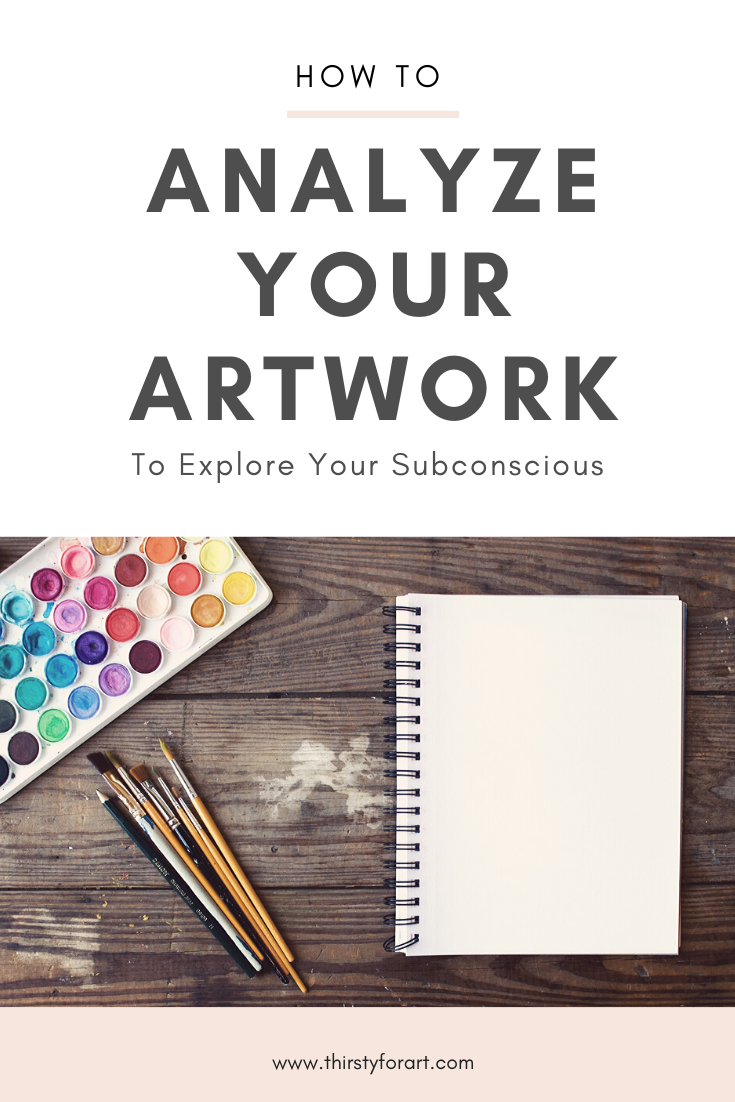How to Analyze Art Like an Art Therapist
How to Analyze Your Artwork Like an Art Therapist
Hello friends, today, I'll show you how to analyze your artwork (i.e., how to interpret your art) to find more meaning and help you learn more about your subconscious.
These prompts and tips will help you change how you look at your artwork.
I’m Youhjung and I do art therapy with people and make art for myself. I have been helping people through art therapy for years and this question of analyzing artwork is a common question I get from folks.
If want to watch the video where I share these tips you can see it here:
What is Analyzing?
But first, what does “analyzing” your art mean?
Based on my dictionary search, analyzing means to examine methodically and in detail for explanation and bring out a meaning (that is not apparent). It also means to discover or reveal something.
So in this context, we’ll define analyzing your artwork to mean to understand or learn about yourself more and to make sense of things through your art.
And, I also want to mention that what I’m sharing here is different from psychological ASSESSMENT that's done by art therapists - this is something that art therapists do professionally and it involves using standardized tests or assessments and scoring methods to evaluate where someone is at psychologically. This is out of the scope of one video or blog post, of course.
What we're doing here is using strategic questions to explore more meaning within your own artwork.
Respecting Others and Yourself
One more thing. Remember to don’t analyze other people’s works. There are art therapists for that.
There’s a lot of nuances, skills, know-hows, and understanding that goes into this and it can be quite dangerous to attempt this without training. (Our biases, our own unresolved issues, etc can come out and cloud our judgment).
Use this to find more meaning within your own artwork.
AND, what you find in your artwork can depend on the situation and timing. So meanings can change, and you can get different meaning each time you analyze your work.
The most important person is YOU - the CREATOR of the artwork, the ARTIST. The one who created the artwork.
You created the work, and it is you who can invest meaning into that artwork, change that meaning if you want to, or put no meaning in it at all.
Analyzing & Interpreting Artwork
In Art Therapy, there are many MANY ways to analyze, to find meaning, to learn about yourself in the artwork. I’ll share a few easy ways you can do that today.
So see this as a starting point, to allow things to emerge, and not pin down things or label yourself.
Let's get started - here are the ways we can learn more about yourself through your artwork.
Use these tips for both abstract and realistic artworks. It might help if you write answers to the questions I am sharing below.
Identify Feeling Words
First, identify what feeling words you get when you look at your own artwork.
Is it happiness, sadness, confusion, or calmness? Or a mixture of all?
Identify Sensation Words
See if you can identify words that represent sensations. This could be feeling warm, hot, cold, claustrophobic, pressured, poky, etc.
How does your artwork make you feel in your body?
Identify what it is similar to
Look at your artwork and see if it makes you think about something particular. This could be a person, a place, another artwork like a poem or music, or situations/events that happened in your life.
What does all of this mean to you?
Now that you have these 3 things written down, ask yourself what do all these answers mean to you?
Does it relate to your life in any way? For example, if you identified that your artwork gives you an anxious feeling, then how does this come up in your own life?
Our artworks can tell us the things that we don’t get to explore in our everyday life.
Use this question “what does this mean to you?” and apply it to all the answers you’ll get from the following questions as well.
What is odd?
Ask yourself, what is odd in the picture/image/artwork. Sometimes there may be things in the work that doesn’t make particular sense logically.
When you find these things, it may be a sign that there is a problem or issue in your life that hasn’t been addressed, noticed, and needs to be explored in some way.
What are the sizes?
The sizes of objects or things inside an image often show the subjective importance of something. If it’s too large, it may mean it’s especially important while if it’s really small, then it may be something that you find no value in, or something that you want to deemphasize.
What’s in the center?
Identify what’s in the center part of your work. This is often suggestive of what is at the core of the problem, or your mind.
You can also try to find what is closest to the center.
What is the perspective?
Identify what is the perspective of your art. And see if there are multiple perspectives in your work.
Perhaps one thing is in human eye level, while another is in bird’s eye point of view.
This may show that there may be inconsistencies in your life. Explore how this may relate to you.
Become the object and see how it feels
Suppose you jump into the picture or artwork and become one of aspect in your work (e.g., an animal, a tree, etc). Imagine what it would feel like, what you would hear, what you would see around you, what you would do, and what your relationship is like to the whole picture (the rest of the artwork).
This can give you a lot of ideas on what feelings, thoughts, and energy your subconscious is communicating to you through art.
Now that you have answered all these prompts, go back to that question of “how does all this relate to my life right now?”
This is a question only you can answer for yourself. Be honest and find out more about your life - what you may be feeling, thinking, and doing subconsciously.
These tips to analyze your own artwork is a powerful and enlightening exercise to bring the subconscious into the conscious.
Last thoughts
We cannot know someone’s entire brain through one single artwork, and art therapists don’t just interpret art using recipes and cookie cutter rules, since each person is totally unique.
In art therapy, it is more about the relationship between the artist, the artwork, the art process, and the therapist.
What are some things you want to learn about yourself through your own artwork? Let me know in the comments below. And make sure to save this page or share it with a friend.
p.s. Here are some suggested further readings on art therapy:
Secret World of Drawings (many of the concepts in this post are based on this writing)
P.P.S. Curious about therapeutic art and want to learn how to facilitate it or incorporate it in your work to help others? Then I’ve got the ✨perfect✨ resource for you. My Therapeutic Art Facilitation School course is THE place where you can learn the foundations of therapeutic art work. I teach you my step by step signature method of using therapeutic art to help people, even if you’re just starting (no artist or therapist background needed). Want to learn how to do this? Check out my therapeutic art course here.
--
* This post may contain affiliate links. If you buy something through one of those links, you won’t pay anything more, but I’ll receive a small commission, which helps me keep making videos & writing blogs for free. Thank you!




